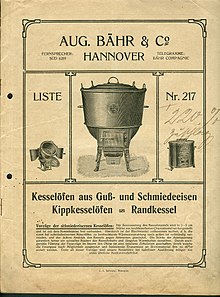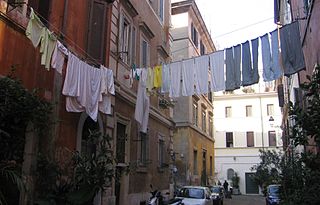
Laundry is the washing of clothing and other textiles, and, more broadly, their drying and ironing as well. Laundry has been part of history since humans began to wear clothes, so the methods by which different cultures have dealt with this universal human need are of interest to several branches of scholarship.

A washing machine is a machine designed to launder clothing. Modern-day home appliances use electric power to automatically clean clothes. The term is mostly applied to machines that use water as opposed to dry cleaning or ultrasonic cleaners. The user adds laundry detergent, which is sold in liquid, powder, or dehydrated sheet form, to the wash water.

A boiler is a closed vessel in which fluid is heated. The fluid does not necessarily boil. The heated or vaporized fluid exits the boiler for use in various processes or heating applications, including water heating, central heating, boiler-based power generation, cooking, and sanitation.

Cookware and bakeware is food preparation equipment, such as cooking pots, pans, baking sheets etc. used in kitchens. Cookware is used on a stove or range cooktop, while bakeware is used in an oven. Some utensils are considered both cookware and bakeware.
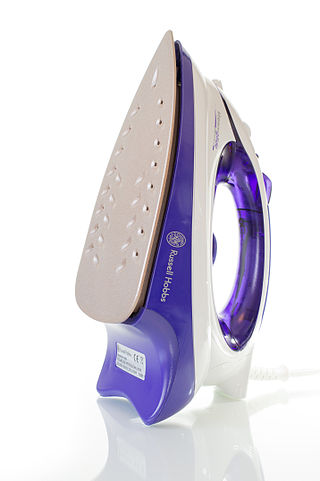
A clothes iron is a small appliance that, when heated, is used to press clothes to remove wrinkles and unwanted creases. Domestic irons generally range in operating temperature from between 121 °C (250 °F) to 182 °C (360 °F). It is named for the metal (iron) of which the device was historically made, and the use of it is generally called ironing, the final step in the process of laundering clothes.

A samovar is a metal container traditionally used to heat and boil water. Although originating in Russia, the samovar is well known outside of Russia and has spread through Russian culture to other parts of Eastern Europe, as well as Western and Central and South Asia. Since the heated water is typically used to make tea, many samovars have a ring-shaped attachment around the chimney to hold and heat a teapot filled with tea concentrate. Though traditionally heated with coal or kindling, many newer samovars use electricity to heat water in a manner similar to an electric water boiler. Antique samovars are often prized for their beautiful workmanship.

Water heating is a heat transfer process that uses an energy source to heat water above its initial temperature. Typical domestic uses of hot water include cooking, cleaning, bathing, and space heating. In industry, hot water and water heated to steam have many uses.
The Japanese kitchen is the place where food is prepared in a Japanese house. Until the Meiji era, a kitchen was also called kamado and there are many sayings in the Japanese language that involve kamado as it was considered the symbol of a house. The term could even be used to mean "family" or "household". Separating a family was called kamado wo wakeru, or "divide the stove". Kamado wo yaburu means that the family was broken.

A saveloy is a type of highly seasoned sausage, usually bright red, normally boiled and available in fish and chip shops around Britain. It is sometimes also available fried in batter.

A fire-tube boiler is a type of boiler invented in 1828 by Mark Seguin, in which hot gases pass from a fire through one or more tubes running through a sealed container of water. The heat of the gases is transferred through the walls of the tubes by thermal conduction, heating the water and ultimately creating steam.
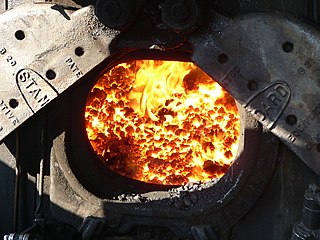
In a steam engine, the firebox is the area where the fuel is burned, producing heat to boil the water in the boiler. Most are somewhat box-shaped, hence the name. The hot gases generated in the firebox are pulled through a rack of tubes running through the boiler.
A superheater is a device used to convert saturated steam or wet steam into superheated steam or dry steam. Superheated steam is used in steam turbines for electricity generation, in some steam engines, and in processes such as steam reforming. There are three types of superheaters: radiant, convection, and separately fired. A superheater can vary in size from a few tens of feet to several hundred feet.

A scullery is a room in a house, traditionally used for washing up dishes and laundering clothes, or as an overflow kitchen. Tasks performed in the scullery include cleaning dishes and cooking utensils, occasional kitchen work, ironing, boiling water for cooking or bathing, and soaking and washing clothes. Sculleries contain hot and cold sinks, sometimes slop sinks, drain pipes, storage shelves, plate racks, a work table, various coppers for boiling water, tubs, and buckets.

A posser, ponch, washing dolly or a poss stick was historically a tool used for possing laundry by pumping the posser up and down on the laundry in the dolly tub or directly in the copper, or mixing laundry while hand washing it. Possers come in various forms; there is usually a vertical pole with a handle bar at the top but the base can be conical or domed. It has a double rim with a row of holes around the edge of the outer one. A similar tool with three legs was called a variety of names including posstick, peggy-legs, dolly-legs, and dolly-peg. Sometimes they took the form of a flat disk. The naming of each of these items was regionally specific and the specific meaning of word changed over time.

A laundry ball or washing ball is a product made of solid, insoluble material promoted as a substitute for laundry detergent. Producers of laundry balls often make pseudoscientific claims about their mechanisms of action and exaggerate the extent of their benefits.
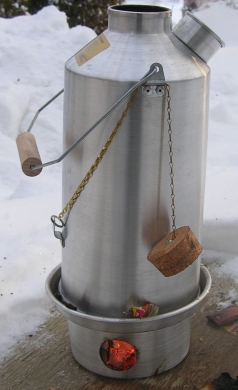
Kelly Kettle, Storm Kettle, Ghillie Kettle, Thermette, Survival Kettle and Volcano Kettle are trade names for portable devices for boiling water outdoors using twigs and other small combustible materials; these devices consist of a water jacket surrounding a fire chamber which creates an upward chimney draft ensuring efficient and rapid boiling even in windy or wet weather.

A combo washer dryer is a combination in a single cabinet of a washing machine and a clothes dryer. It should not be confused with a "stackable" combination of a separate washing machine and a separate clothes dryer.

A boiler or steam generator is a device used to create steam by applying heat energy to water. Although the definitions are somewhat flexible, it can be said that older steam generators were commonly termed boilers and worked at low to medium pressure but, at pressures above this, it is more usual to speak of a steam generator.
Boilers for generating steam or hot water have been designed in countless shapes, sizes and configurations. An extensive terminology has evolved to describe their common features. This glossary provides definitions for these terms.

